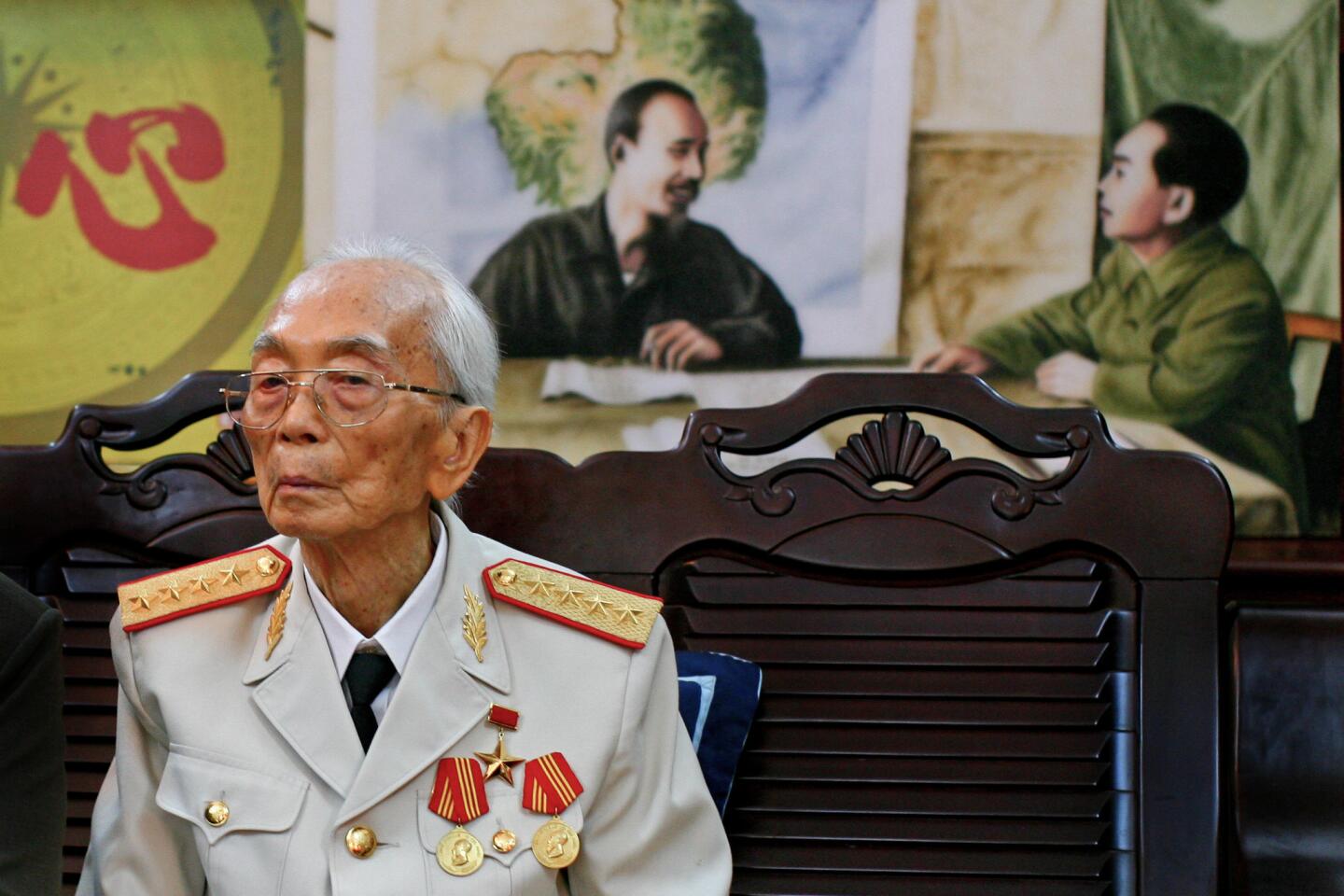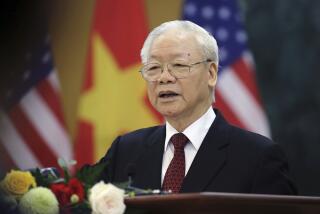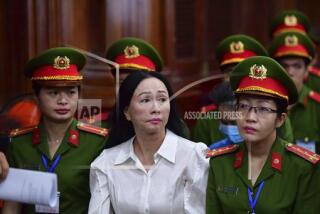Vo Nguyen Giap dies at 102; Vietnamese general led North to victory
Vo Nguyen Giap, the communist general widely regarded as one of the military geniuses of the 20th century, who masterminded the defeat of the French and the war against the Americans in Vietnam, has died. He was 102.
Giap died Friday at a military hospital in Hanoi, the Associated Press reported, citing a government official.
Though Ho Chi Minh was the symbol of Vietnam’s fight for independence and reunification, it was Giap who carved out the victories. From Dien Bien Phu to Khe Sanh to the Tet offensive, his name became synonymous with the battles that defined a chapter of world history and emboldened liberation movements from Africa to Latin America.
A man of little pretense and great ambition, Giap had no formal military training and used to joke that he was a self-taught general. His early nationalistic calling was as a writer and propagandist. Never having touched a gun, he protested when Ho ordered him to prepare for a war with France: “I wield a pen, not a sword.”
But he followed orders, and on Christmas Eve 1944 he and a band of 33 partisans armed with knives and flintlock rifles attacked two isolated French outposts. Thirty years later, with the French gone and the U.S.-backed South Vietnamese forces now near collapse, his army was the world’s third largest, numbering 800,000. Through three decades of war, he was his nation’s supreme military commander, a service record with few, if any, parallels in modern times.
Giap understood what the French and Americans did not: that a peasant army, imbued with patience, nationalism and a willingness to endure untold suffering, could defeat a far more powerful force whose cause was not enthusiastically supported at home. Giap lost an estimated 1 million communist soldiers in winning Vietnam’s independence as a unified state, but he never expressed the slightest doubt that such huge casualties were worth the sacrifice.
“Every minute, hundreds of thousands of people die on this Earth,” Giap said in 1969, adding that he was prepared to fight as long as necessary for ultimate victory. “The life or death of a hundred, a thousand, tens of thousands of human beings, even our compatriots, means little.”
Said Gen. William Westmoreland, the U.S. commander in Vietnam during the 1968 Tet offensive: “Giap was callous. Had any American general taken such losses, he wouldn’t have lasted three weeks.”
In later life, Giap — a short, white-haired man with a round face and soft hands—had lived quietly in Hanoi in a downtown villa, deified by the city’s residents as a national hero. His parlor was lined with busts and portraits of Marx, Lenin and Ho Chi Minh. He chatted with visitors in perfect French, sometimes receiving them in his military uniform, and could recall various campaigns — Napoleon’s and his own — in brilliant detail.
He saw the war against the United States as merely an extension of the war against France and always believed that Washington’s resolve eventually would wither, as had Paris’. “You can kill 10 of my men for every one I kill of yours,” he once said to the Americans, repeating what he had warned the French more than a decade earlier. “But even at those odds, you will lose and I will win.”
Toward the end of his long life, Giap spoke out strongly, although unsuccessfully, on another issue. His was one of the most prominent voices to urge the Vietnamese government in 2009 to reconsider its plans for a vast Chinese-run bauxite mining operation in Vietnam’s central highlands, which Giap and others said posed environmental and security risks. But the project proceeded.
Giap was born Aug. 25, 1911, in the village of An Xa, just north of what would become the Demilitarized Zone. His father was a scholarly rice farmer who taught Giap to read — the first book he read was a child’s history of Vietnam — and who scrimped to send his son to the best schools available.
Young Giap attended the prestigious Quoc Hoc academy in Hue, whose alumni included Ho Chi Minh and Ngo Dinh Diem, an intense anti-Communist who would become prime minister of South Vietnam. Giap, then just 13, began reading Marx, organized student protests against France’s ban on nationalistic activities and was expelled.
By 1938, he was a professional agitator. He had spent time in a French prison, earned a law degree from Hanoi University, taught history in a private school to support himself and married a communist militant, Minh Khai. They had one child, a daughter, Vo Hong Anh, who would become a nuclear physicist and who would win, in 1987, the Soviet Union’s Kowolenskia Prize for Science.
Nationalistic fervor was building against the French at the onset of World War II, and in 1940, at the age of 28, Giap moved across Vietnam’s border to Yenan in southern China. It is not clear whether he learned guerrilla tactics there from actual training or from reading, but it is known that the next year, at a communist gathering in China’s Guangxi province, he first met Ho Chi Minh, then a widely known revolutionary who had not set foot in Vietnam for 30 years.
“Ho immediately took a liking to the young firebrand,” historian Bernard Fall wrote, “and entrusted him with a most difficult mission: the organization of a communist military force inside Vietnam.”
Back in Vietnam, Giap lived for the next four years in caves and jungles with a small band of cadres, organizing a resistance movement and hunted by French patrols. He wore sandals with soles made from automobile tires and, with his men, often ate bark and roots. The structure of the camp was egalitarian, and the chore Giap assigned himself was that of dishwasher.
In 1943, Giap received news that devastated him. Shortly after he had left Hanoi, his sister-in-law, returning from Paris, had been arrested by the French and executed as a revolutionary. His wife had been imprisoned on similar charges, and he learned that she had died in the French prison that eventually would house American POWs and become known as the Hanoi Hilton. Giap would later remarry and father five more children, but he once told an interviewer that news of Minh Khai’s death “ruined” his life.
Giap’s army, known as the Viet Minh, now a formidable guerrilla force, fought both Japanese occupiers and French colonialists during World War II. Giap hoped the United States would support Vietnam’s bid for independence and told a crowd in Hanoi in 1946 to regard the United States as a “good friend” because “it is a democracy without territorial ambitions.”
But the war between Vietnam and France started in earnest that year, and between then and 1954, when France surrendered at Dien Bien Phu — ending 71 years of colonial rule — Washington backed France with $4 billion in military aid. The battle for Dien Bien Phu claimed the lives of about 8,000 Viet Minh and 2,000 French.
Although the U.S. Joint Chiefs of Staff had rejected France’s plea for American intervention in the final days of Dien Bien Phu, saying “Indochina is devoid of decisive military objectives,” the United States, by the mid-1960s, found itself being drawn into the same quagmire that had trapped the French.
Facing the world’s mightiest military power, Giap created the so-called Ho Chi Minh Trail to move supplies south and designed networks of tunnels in which his soldiers lived, cared for the wounded and planned battles. Armed by Moscow, Giap built an air defense system that the Americans themselves admitted was second only to NATO’s in sophistication. He changed his tactics, from guerrilla skirmishes to main-force confrontation.
“Confuse your enemy,” Giap wrote. “Keep him in the dark about your intentions.”
In late 1967, wanting to draw the Americans away from the coast so he could attack South Vietnam’s cities, Giap began building up his forces around an isolated U.S. base at Khe Sanh. The Americans reinforced their position and were besieged for 75 days. Remembering how the French had met their Waterloo, President Lyndon B. Johnson told his advisors: “I don’t want another Dinbinphoo.”
“Khe Sanh was not important to us,” Giap told his biographer, Peter Macdonald. “It was only a diversion, but one to be exploited if we could cause many casualties and win a big victory.”
While the world’s attention was riveted on Khe Sanh, Giap turned 70,000 Communist troops loose in January 1968—on the first day of the lunar new year celebration—in a widespread attack against South Vietnam’s cities. A suicide squad made it into the U.S. Embassy complex in Saigon.
Although Giap’s forces suffered tremendous losses in what became known as the Tet offensive, the campaign shocked the American public, which had been told that North Vietnam was incapable of fighting much longer, and undermined public support for the war.
Under internal pressure to make peace at any price, the United States negotiated an end to the conflict in Paris in 1972. It agreed to withdraw all U.S. forces but did not insist that North Vietnam also withdraw its troops from the South. On Jan. 6, 1975, Giap launched a major attack against South Vietnam, estimating that his campaign to reunite Vietnam would take two years. Fifty-five days later, Saigon fell to North Vietnam to secure the victory Giap had sought all his adult life.
“If I had not become a soldier,” he told writer Stanley Karnow, “I probably would have remained a teacher, maybe of philosophy or history. Someone recently asked me whether, when I first formed our army, I ever imagined I would fight the Americans. Quelle question! Did the Americans, back then, ever imagine that they would one day fight us?”
Lamb is a former Times staff writer.
More to Read
Start your day right
Sign up for Essential California for the L.A. Times biggest news, features and recommendations in your inbox six days a week.
You may occasionally receive promotional content from the Los Angeles Times.







